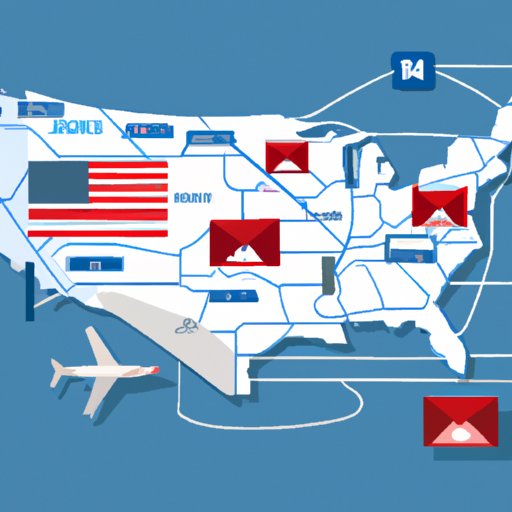Introduction
Have you ever wondered how your letter gets from you to its destination, even if it’s on the other side of the country? How does it get there so quickly? The process of sending and receiving mail is one that has been around for centuries, but it has developed significantly over time. This article will explore the journey of an outgoing letter and look at how mail travels across country.

Tracing the Journey of an Outgoing Letter: A Look at How Mail Travels Across Country
The postal system is a complex network that is responsible for delivering mail to its intended destinations. It consists of a variety of elements, such as post offices, sorting facilities, and transportation services. Each of these components works together to ensure that mail is delivered safely and promptly.
There are two types of mail delivery: local and long-distance. Local mail is typically delivered within a few days, while long-distance mail can take up to a week or more depending on where it is going. Tracking a letter through different stages can help you understand how long-distance mail is delivered.
When a letter is sent, it is first collected by the post office and sorted according to its destination. From there, the letter is sent to the appropriate sorting facility and then loaded onto a truck or plane. The letter is then transported to its destination, where it is sorted again and delivered to the recipient.
The Science Behind Mail Delivery: How Does it Move So Quickly?
Mail delivery is a complex process that involves many different factors. The speed of delivery depends on the distance being traveled, the type of mail being sent, and the volume of mail being processed. Additionally, the availability of technology and automation has increased efficiency and allowed for faster delivery times.
Technologies such as barcode scanners, automated sorting machines, and computerized tracking systems have allowed postal workers to track and trace mail more efficiently. This technology also allows postal workers to identify any potential issues that may arise during the delivery process, such as delayed or lost mail.
Automation has also helped to increase the speed of mail delivery. Automated sorting machines can quickly sort mail according to its destination and load it onto the appropriate truck or plane. Additionally, automated tracking systems allow postal workers to quickly locate mail that has been delayed or lost.
Uncovering the Secrets of Long-Distance Delivery: The Mechanics of Moving Mail Across Country
Long-distance delivery involves a number of processes, from sorting to packaging and tracking. To begin the process, mail is sorted according to its destination and packaged for transport. The package is then loaded onto a truck or plane and transported to its destination.
The cost of long-distance delivery depends on the weight and size of the package, as well as the distance being traveled. Additionally, the cost can vary depending on the type of service being used. For example, express mail is typically more expensive than regular mail.
Technology plays an important role in the long-distance delivery process. Computerized tracking systems allow postal workers to quickly locate mail that has been delayed or lost. Additionally, automated sorting machines can quickly sort mail according to its destination and load it onto the appropriate truck or plane.
A Glimpse Into the Modern Postal Network: How Mail is Delivered Around the United States
The United States Postal Service (USPS) operates a national postal network that is responsible for delivering mail throughout the country. The network consists of regional and local post offices, sorting facilities, and transportation services. Additionally, each state has its own postal system that is responsible for delivering mail within its borders.
Each region has its own unique characteristics that affect the way mail is delivered. For example, some regions may have larger post offices that are able to handle more mail, while others may have smaller post offices that are limited in their capacity. Additionally, some regions may have more advanced sorting and tracking technologies than others.
Local postal systems also play an important role in mail delivery. Local post offices are responsible for collecting and sorting mail, as well as delivering it to its final destination. Additionally, they are responsible for providing customer service to those who need assistance with their mail.
Conclusion
The process of sending and receiving mail is complex and involves many different elements. This article explored the journey of an outgoing letter and looked at how mail travels across country. It examined the postal system, the types of mail delivery, and the science behind mail delivery. Additionally, it uncovered the secrets of long-distance delivery and looked at how mail is delivered around the United States.
Overall, this article has provided an in-depth look at the mechanics of long-distance delivery. It has shown how technology and automation have increased efficiency and allowed for faster delivery times. Additionally, it has highlighted the importance of the postal system and local postal systems in ensuring that mail is delivered safely and promptly.
For further reading, we recommend exploring the history of the postal system and examining the various technologies used to track and trace mail. Additionally, we suggest researching the costs associated with long-distance delivery and understanding the impact of local postal systems.
(Note: Is this article not meeting your expectations? Do you have knowledge or insights to share? Unlock new opportunities and expand your reach by joining our authors team. Click Registration to join us and share your expertise with our readers.)
